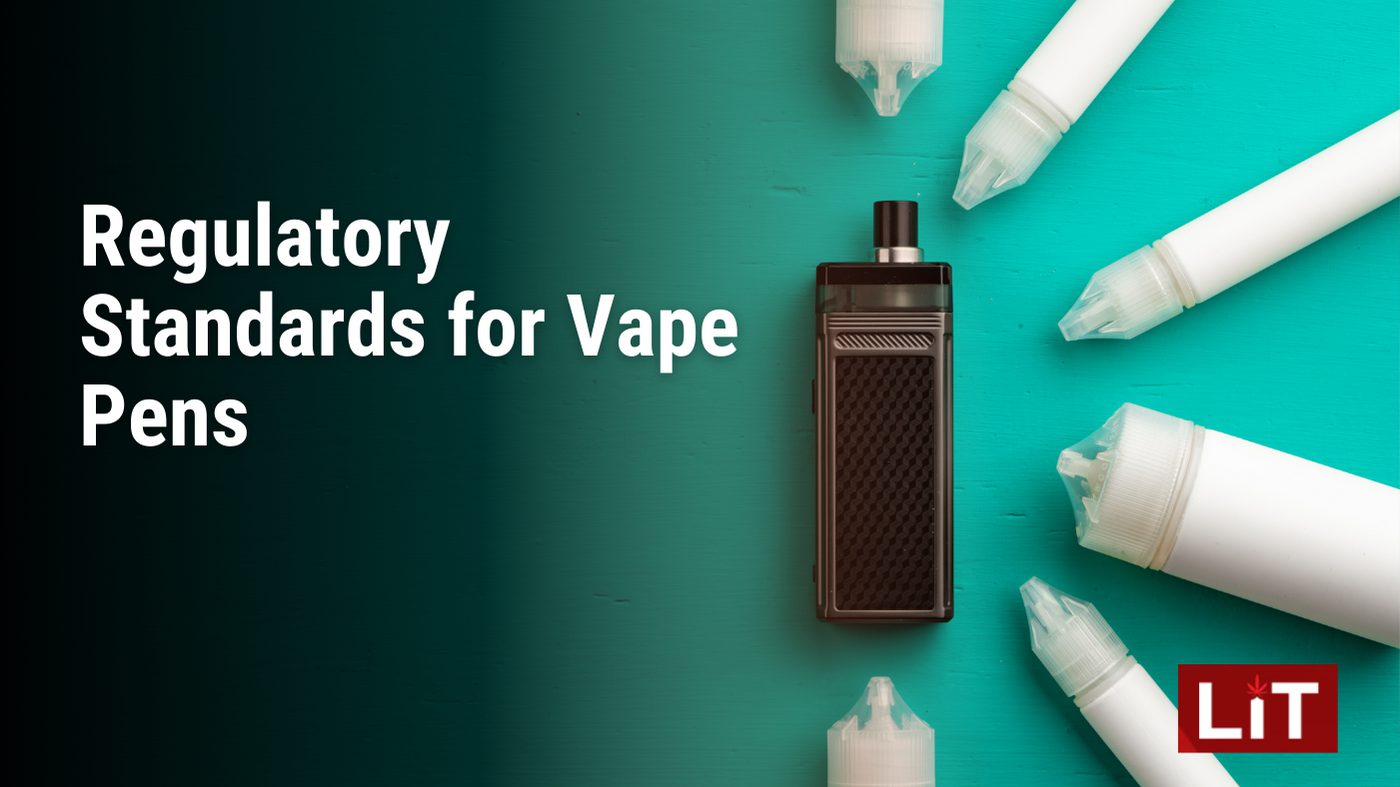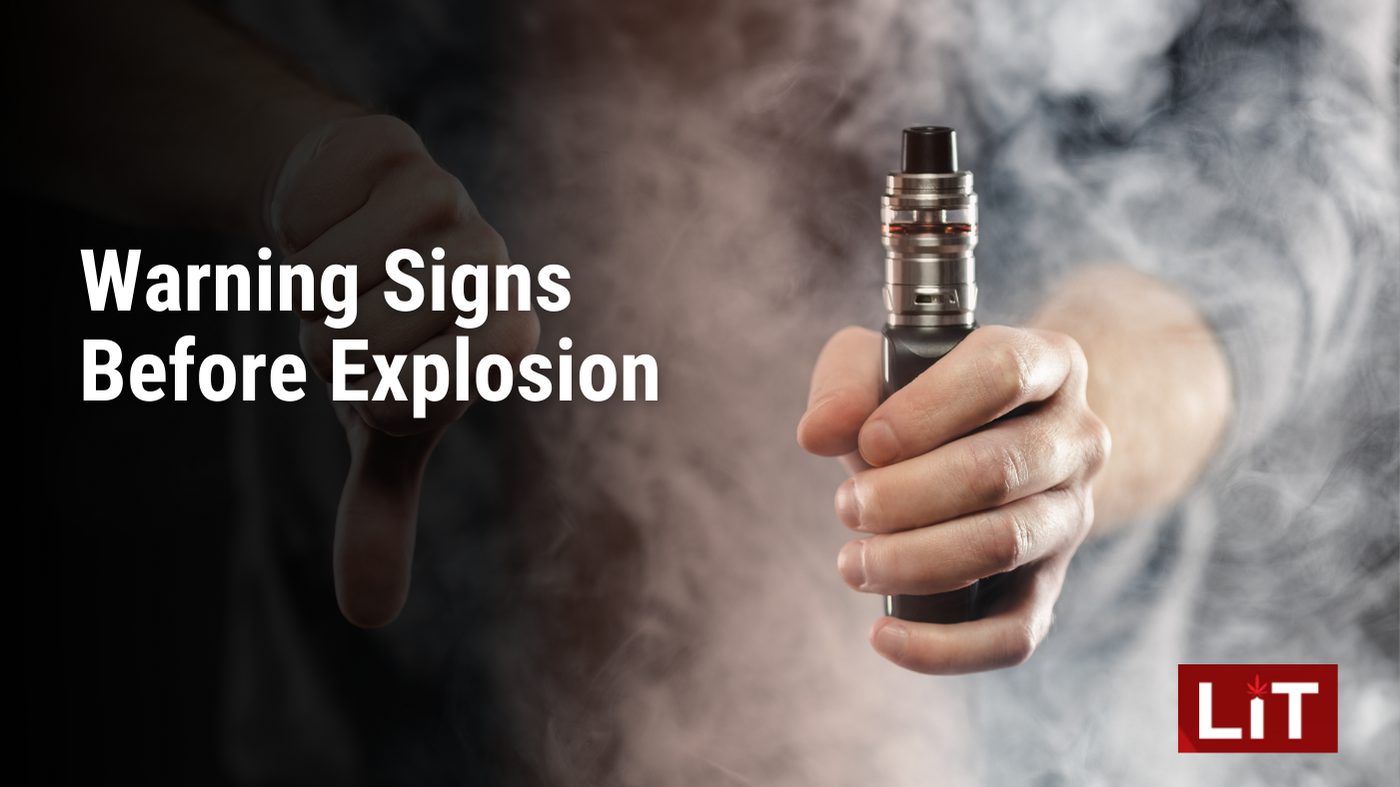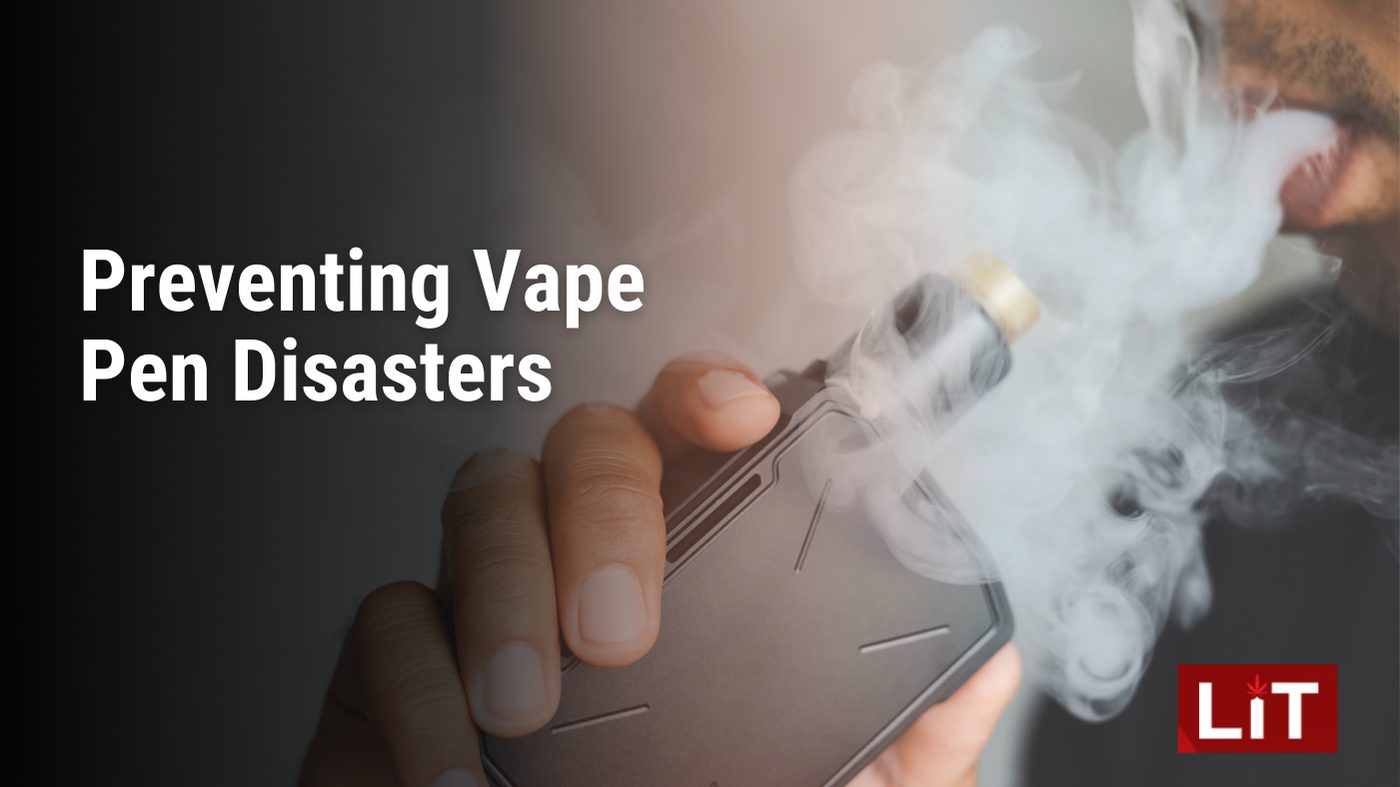Yes, vape pens can explode, though such incidents are relatively rare. The primary cause of explosions in vape pens is related to the lithium-ion batteries they use. Mishandling, using incompatible chargers, and exposure to extreme temperatures can lead to battery malfunctions and, subsequently, explosions. Proper maintenance and following manufacturer guidelines significantly reduce the risk of such events. Using vape pens that include safety features like automatic shutoff mechanisms is also recommended to guarantee additional protection. Understanding the specifics of battery care and device selection can further enhance your safety. More insightful details follow on maximizing safety while using these devices.
Key Takeaways
- Vape pens can explode due to battery mishandling, misuse, or damage.
- Overcharging or using incompatible chargers increases the risk of overheating and explosions.
- Between 2009 and 2016, 195 vape pen explosions were reported in the U.S.
- Short circuits in lithium-ion batteries can ignite flammable electrolytes, leading to explosions.
- Avoiding cheap or counterfeit products and using devices with advanced safety features can reduce explosion risks.
Components of a Vape Pen

A vape pen primarily comprises a battery, atomizer, coil, and tank designed to hold e-liquid. Each component plays a vital role in the vape pen’s functionality, but the battery often raises safety concerns. The focus frequently shifts to lithium-ion batteries in the discourse around whether vape pens can explode. These batteries are standard in many electronic devices due to their rechargeability and efficiency, but they come with risks if not handled properly.
Why do vape pens explode? The answer primarily lies in the mishandling or malfunction of these batteries. Lithium-ion batteries can be volatile if exposed to damaging conditions. For instance, using a non-specified charger, overcharging, or exposure to extreme temperatures can compromise the battery’s integrity. This can lead to thermal runaway—a condition where increasing temperature causes further temperature increases, often resulting in an explosion or fire.
Furthermore, physical damage to the battery, such as punctures or impacts, can disrupt its internal structure, leading to dangerous chemical reactions. The risk of explosion is exacerbated if the battery’s protective casing is compromised, allowing metal objects to come into contact with its terminals.
To significantly reduce the risk of explosions, the battery should be handled carefully, used appropriately, and exposure to harsh conditions avoided. Users should be educated on proper maintenance and storage of vape pens to guarantee safety and prolong the life of the device. Therefore, while vape pens can explode, understanding and respecting the device’s components, particularly the battery, is critical to safe usage.
How Vape Pens Work
Understanding the operation of vape pens is essential, as they function by heating a coil that vaporizes the e-liquid into an aerosol for inhalation. This process begins when the user activates the device by pressing a button or drawing air through the mouthpiece. This action triggers the battery to supply power to the heating element, or coil, located within the atomizer component. The coil then heats to a specific temperature, vaporizing the e-liquid soaked into the surrounding wicking material.
The e-liquid is a mixture of propylene glycol, vegetable glycerin, flavorings, and often nicotine, which turns into vapor upon heating. This vapor is then drawn through the device and inhaled by the user, delivering flavor and nicotine, if present, without the combustion involved in traditional smoking methods. The precise control over temperature and power settings can influence the amount and flavor of the vapor produced, allowing users to customize their vaping experience.
Safety features are integral to the design of modern vape pens to prevent overheating and potential malfunctions. These include automatic shutoff mechanisms that deactivate the coil if it gets too hot or if the device is activated for too long. Thermal monitoring and voltage regulation are also commonly incorporated to maintain steady and safe operation.
Through these mechanisms, vape pens offer a smokeless alternative to cigarettes. They utilize simple yet effective technology to deliver vapor efficiently and safely, provided they are operated within the guidelines recommended by manufacturers.
Battery Types Explained
Building on the technical foundation of how vape pens operate, it is essential to explore the types of batteries they use, mainly focusing on lithium-ion batteries and their safety features. Lithium-ion batteries are preferred in vape pens because they can compactly store substantial amounts of energy. They are rechargeable, which adds to the importance and cost-effectiveness for users. However, the characteristics that make lithium-ion batteries efficient also demand stringent safety measures.
Lithium-ion batteries function by moving lithium ions between the cathode and anode. While efficient, this process can be volatile if the battery is damaged or improperly handled. Modern vape pens often incorporate battery management systems that protect against overcharging, deep discharge, and short-circuiting to enhance safety. These systems are critical in maintaining battery integrity and preventing thermal runaway, where an increase in temperature accelerates a further temperature rise, often leading to catastrophic failure.
Additionally, it is essential to understand specifications like voltage, capacity (measured in milliampere-hours, mAh), and the type of lithium-ion battery (such as IMR, INR, and ICR). Each type has different chemistries and performance characteristics, impacting the overall safety and efficiency of the vape pen.
Users must adhere to manufacturer guidelines for charging and storage, always use the charger provided with the device, and replace batteries that show any sign of damage or significant wear. Awareness and education on properly handling these batteries are paramount in mitigating risks associated with their use in vape pens.
Causes of Vape Pen Explosions

Vape pen explosions often result from battery damage, misuse, or mishandling. Lithium-ion batteries, commonly used in these devices, are susceptible to various issues that can lead to dangerous outcomes. Overcharging these batteries or using an incompatible charger can disrupt the internal chemical balance, leading to overheating and potential explosion. Similarly, exposing batteries to extreme temperatures, especially heat, exacerbates these risks by further destabilizing the battery’s structure and function.
Another significant factor in vape pen explosions is physical damage to the batteries. Drops, impacts, or even minor dents can compromise the integrity of the battery casing, leading to short circuits. Short circuits can also occur due to improper storage, such as carrying batteries loose in a pocket with metal objects like coins or keys, which can bridge connections between the positive and negative terminals.
Using damaged wraps or low-resistance coils can further contribute to the risk. Damaged wraps expose the battery’s metal casing, making accidental shorts more likely, while low-resistance coils draw excessive current, straining the battery beyond its safe operational limits.
User error plays an important role, particularly when individuals use counterfeit or low-quality batteries that do not meet safety standards. These substandard products often lack the necessary safety mechanisms to prevent overcharging and overheating. Regular maintenance and vigilance in handling and choosing vape batteries are essential to mitigating these risks. Educating users about proper battery care and purchasing from reputable sources is vital to prevent such hazardous incidents.
Statistics on Vape Pen Safety
Statistics reveal a concerning trend in the safety of vape pens, with 195 explosions reported by the U.S. Fire Administration between 2009 and 2016. These incidents have spotlighted not only the potential hazards associated with vaping devices but also the need for stricter regulations and standards regarding their manufacture and use.
The data presented by the U.S. Fire Administration indicates that most of these explosions are linked to battery malfunctions. Lithium-ion batteries, commonly used in these devices, are prone to overheating if damaged, overcharged, or subjected to extreme temperatures. This can lead to thermal runaway, a condition in which an increase in temperature causes a further increase, often resulting in an explosion.
In response to these statistics, there has been a push for better consumer education on handling and maintaining vape pens. Users are advised only to use the charger provided with their device, regularly inspect their batteries for signs of damage, and avoid exposing their vape pens to extreme temperatures. Additionally, many newer models now include safety features to prevent overheating and battery failures.
Despite these improvements, the number of incidents involving vape pens highlights a significant need for ongoing monitoring and research into their safety. Manufacturers are urged to continually enhance their products’ safety features and adhere strictly to quality control standards. Meanwhile, regulatory bodies are tasked with updating safety guidelines to keep pace with technological advancements in vaping technology, ensuring that users can rely on their devices not to malfunction catastrophically.
Personal Injury Reports
While the statistical data provides an overview of the safety concerns, individual personal injury reports offer a closer look at the severe consequences suffered by users of exploding vape pens. These incidents underscore the potentially devastating impact of such explosions, which often result in serious physical injuries alongside considerable emotional and psychological trauma.
Many of the reported cases detail severe burns and tissue damage, which not only cause immediate harm but often require extensive and prolonged medical interventions. Victims frequently face surgeries, including skin grafts, to repair the damage inflicted by the explosions. The presence of burns, especially those of a higher degree, typically means a long road to recovery and a significant alteration in the quality of life during that period.
Moreover, the personal injury reports reveal that cuts and facial injuries are common. These injuries can lead to permanent scarring and disfigurement, profoundly affecting the victim’s self-esteem and day-to-day social interactions. Such outcomes highlight these injuries’ critical nature and long-term implications on an individual’s physical appearance and mental health.
In addition to the physical injuries, victims often endure emotional distress and psychological trauma. The sudden and violent nature of vape pen explosions can lead to ongoing psychological effects, such as post-traumatic stress disorder (PTSD), which may necessitate further treatment and support.
Collectively, these personal injury reports not only document the acute consequences of vape pen explosions but also chart the long and often painful journey that survivors must undertake toward recovery, emphasizing the severe risks associated with these devices.
Analyzing Explosion Incidents

Analyzing recorded incidents of vape pen explosions provides essential insights into the common causes and preventative measures. While the malfunction often relates to battery issues, other factors contribute significantly to these dangerous occurrences. Reports indicate that physical handling and environmental conditions play critical roles. For instance, carrying a vape pen in a pocket where it can be subjected to physical stress or come into contact with coins and keys has led to accidental short circuits and subsequent explosions.
Observing incidents also shows that users’ modifications to the device or its components can precipitate failures. In pursuit of enhanced performance, some users modify the heating elements or circuitry, unknowingly setting the stage for thermal runaway. In this condition, an increase in temperature changes the conditions, causing a further temperature rise, often leading to an explosion.
Furthermore, usage scenarios contribute to these incidents. For example, using a vape pen while charging can increase the risk of overheating. Public awareness campaigns have stressed the importance of not using the device while charging and ensuring it is attended to.
Education on proper storage and handling can drastically reduce these incidents. Users must be aware of the environment in which they store their vape devices—extreme temperatures, for instance, can compromise battery integrity and function. The collective data from these incidents point towards a significant need for stringent manufacturing standards and thorough user education to prevent future occurrences. Ensuring devices meet specific safety benchmarks and users adhere to recommended practices is crucial.
Role of Battery Failures
Understanding the role of battery failures is vital to comprehending why vape pens can sometimes explode. The core issue often lies in the lithium-ion batteries that power these devices. These batteries are susceptible to failures, including short circuits, overcharging, and physical damage, which can precipitate dangerous outcomes. A short circuit in the battery can occur if the thin separator between the electrodes is compromised, allowing the electrodes to contact each other and create an internal spark. This spark can ignite the highly flammable electrolytes within the battery.
Overcharging is another critical risk factor. Vape pens typically require specific chargers that regulate the charge current. Using an incompatible charger can lead to excessive current flow, overheating the battery, and potentially causing a thermal runaway—a condition where increasing heat releases more energy, which further increases heat, leading to an explosion or fire.
Physical damage to the battery, such as punctures or significant impacts, can also lead to catastrophic failures. Such damage can disrupt the battery’s internal structure, leading to a short circuit or even direct exposure of the internal components to air, which might ignite the electrolytes.
Given these risks, a significant number of vape pen explosions can be traced back to battery failures. These incidents highlight the volatile nature of lithium-ion batteries and underscore the necessity of proper handling and usage to guarantee safety. Understanding these factors is vital for manufacturers and users to minimize the risk of such dangerous occurrences.
Importance of Device Maintenance
Regular maintenance of vape pens is essential for preventing potential explosions and ensuring their safe operation. By conducting routine inspections and care, users can significantly reduce the risks associated with their devices. This involves examining the vape pen for any signs of damage or wear that could compromise its integrity. Specifically, checking the battery wraps for tears or other damage is essential, as exposed cells can lead to short circuits, increasing the risk of malfunction.
Cleaning the connections within the vape pen is also important. Dirt, dust, or e-liquid residue can accumulate at the connection points, potentially causing poor conductivity and overheating issues. Users should ensure these areas are clean and free from obstruction to maintain excellent performance and safety. Proper battery insertion must also be observed to prevent misalignment, which could lead to dangerous outcomes.
Moreover, it is essential to adhere to charging guidelines specified by the manufacturer. Overcharging the vape pen or using an incompatible charger can lead to battery failures. Ensuring the correct charger and disconnecting the device once fully charged are simple yet effective steps in maintaining the device’s longevity and safety.
Lastly, following the manufacturer’s maintenance guidelines not only prolongs the life of the vape pen but also safeguards the user. These guidelines are designed to address the specific needs and vulnerabilities of the device, providing clear instructions on how to properly handle and care for the product. Ignoring these instructions can lead to improper use, which may increase the risk of an explosion.
Recognizing Faulty Batteries

Identifying a faulty battery is essential, as signs such as unusual heating, smoke, or peculiar odors can indicate serious safety risks with your vape pen. These symptoms often suggest that the battery may be on the verge of failing or could potentially explode if further mishandled. Users must know these warning signs to maintain safety and prevent accidents.
Other indicators should be considered, such as reduced vapor production or unfamiliar noises emanating from the device. These anomalies could also point toward battery issues that may compromise the integrity and functionality of the vape pen. Observing any decrease in performance or strange sounds can be crucial in diagnosing a problem early before it escalates into a more severe situation.
Physical examination of the battery itself can reveal telltale signs of distress. Users should regularly inspect their batteries for any signs of damage, such as leaks or deformities. A battery that appears swollen, punctured, or leaks any substance is unsafe and should be appropriately disposed of immediately. Such physical defects indicate a faulty battery and pose significant risks of overheating and explosion.
It is essential to promptly recognize these signs of a faulty battery to guarantee continued safe use of vape pens. Addressing these issues by ceasing the use of damaged or compromised batteries can significantly reduce the risk of accidents, thereby enhancing the overall safety of vaping practices.
Safe Charging Practices
Adhering to safe charging practices for vape pens is essential to minimizing the risk of battery explosions. The primary rule of thumb is always to use the charger with your vape kit. These chargers are specifically designed to match the electrical requirements of the vape pen’s battery, significantly reducing the risk of overcharging or causing electrical mishaps.
It is also advisable not to leave vape pens charging overnight. Extended charging can lead to overheating, which might damage the battery and pose serious fire hazards. Instead, charge your vape pen during the day or when you can monitor it to ensure it does not exceed the recommended charging time.
Investing in an external vape battery charger can be a wise decision for those who use vape pens frequently. These chargers often come with additional safety features, such as overcharge protection and automatically cutting off power once the battery is fully charged. This prolongs the battery’s life and minimizes the risk of explosions.
Following the manufacturer’s guidelines is crucial. These instructions provide specific details about the charging requirements and maintenance of the battery that, if ignored, can lead to dangerous situations. Using a charger different from the one specified by the manufacturer can lead to incompatibility issues, potentially resulting in battery failure.
Choosing Quality Vape Pens
In addition to following safe charging practices, selecting high-quality vape pens is vital for guaranteeing safety and reliability in vaping experiences. High-quality devices often incorporate advanced safety features such as short-circuit protection, temperature control, and automatic shutoff that significantly reduce the risk of malfunctions that could lead to battery failures or explosions. These features help to regulate the power output and maintain the battery within safe operating temperatures, thereby protecting the user and extending the life of the device.
When choosing a vape pen, opting for reputable brands known for their dedication to quality and safety is essential. These manufacturers invest in research and development to innovate safer technologies and adhere to higher production standards. Products from these brands are more likely to have undergone rigorous testing to meet safety criteria before hitting the market.
Moreover, reading user reviews and testimonials can provide insight into the reliability and performance of different vape pens. Feedback from actual users often highlights potential issues and overall satisfaction with the device’s functionality and durability. This information can be invaluable in making an informed choice.
Lastly, it is paramount to avoid cheap or counterfeit products. These often lack the essential safety mechanisms required for secure operation and are more susceptible to defects. Investing in a slightly more expensive but thoroughly tested vape pen can lead to a safer and more enjoyable experience. Always verify the authenticity of your purchase to ensure you receive a product that adheres to safety standards and is less likely to cause harm.
Regulatory Standards for Vape Pens

Vape pens are subject to strict regulatory standards from organizations like the FDA and ASTM International to guarantee their safety and reliability. These bodies enforce guidelines that manufacturers must follow to mitigate risks associated with the devices, particularly those stemming from their lithium-ion batteries. The standards cover various aspects of design, manufacturing, and performance to ensure that each device is safe for consumer use.
The FDA, for example, focuses on ensuring that vape pens do not pose undue risks to users. This includes regulations concerning vape liquids’ chemical composition, the devices’ structural integrity, and the electrical components’ safety. ASTM International provides additional standards, particularly in battery safety and quality control. These standards require rigorous testing of the batteries used in vape pens to prevent issues like overheating, leakage, or explosions.
To comply with these regulatory standards, manufacturers must conduct extensive testing and quality assurance processes during production. This includes checks for defects, battery life assessments, and evaluations of device durability under various conditions. Furthermore, clear labeling must inform users about proper usage and potential risks.
Adherence to these regulations helps prevent hazardous incidents and boosts consumer confidence in vape products. Regulatory bodies play an essential role in protecting public health and fostering industry accountability by ensuring that all vape pens on the market have met strict safety criteria. Manufacturers violating these standards face penalties, including fines and product recalls, further underscoring the importance of compliance.
How to Store Vape Pens Safely
Understanding the regulatory standards for vape pens sets the stage for discussing proper storage practices that further enhance safety. Proper storage is not only a vital precaution but a necessary step to guarantee the longevity and reliability of vape pens. Vape pens, like any electronic device that uses lithium-ion batteries, require specific conditions to maintain peak performance and prevent potential hazards.
Firstly, storing vape pens in a cool, dry place is essential. High or low temperatures can affect the battery’s efficiency and safety, increasing the risk of malfunction or explosion. Thus, avoiding places like cars on hot days or cold, damp locations is crucial. Direct sunlight can also lead to overheating, which should be avoided.
Secondly, using a designated battery case for storing vape pens and their batteries can prevent accidental contact with metal objects, such as keys or coins, which can cause the battery to short-circuit. This type of physical protection safeguards the battery from environmental factors and minimizes the risk of mechanical damage.
Additionally, it is advisable to keep vape pens away from water or any moisture. Exposure to liquid can lead to short-circuiting, which not only damages the device but can also pose a severe safety threat. Regular device inspection for any signs of damage or wear is crucial. Checking for issues such as battery leakage, casing damage, or a loose battery connection can prevent many common problems associated with vape pen storage.
Impact of Aftermarket Accessories
Aftermarket accessories, such as batteries or chargers, can significantly impact the safety and functionality of vape pens. When users opt for non-original or low-quality replacements, they significantly increase the risk of malfunction. These accessories often lack the rigorous testing and safety standards adhered to by the original manufacturers, potentially leading to dangerous outcomes. For instance, an incompatible charger might deliver an incorrect voltage or current, leading to overheating and even battery failure.
Poorly designed aftermarket batteries might not have the necessary protective features, such as overcharge protection, which prevents overheating and explosions. Therefore, using such batteries can be a gamble that puts users at unnecessary risk. Additionally, these accessories can sometimes be misleadingly marketed, suggesting compatibility where none exists, further exacerbating safety issues.
Users must select accessories recommended explicitly by the device’s manufacturer. Reputable brands often provide a list of compatible accessories designed to work safely and efficiently with their products. Adhering to these recommendations can drastically reduce the likelihood of accidents.
Warning Signs Before Explosion

Several warning signs can indicate when a vape pen is at risk of exploding, including overheating, unusual smoke, and strange noises. Overheating is one of the most common indicators. A vape pen that feels unusually hot to the touch may be experiencing internal issues that could lead to battery failure and explosion. If the device starts generating excessive heat, it’s advisable to stop using it immediately.
Another critical warning sign is the emission of unusual smoke or a foul odor. Vape pens are designed to vaporize liquids efficiently without burning them. Smoke, as opposed to vapor, and unpleasant smells can indicate a malfunctioning coil or more severe issues like a battery fault. This deviation from regular operation usually precedes more serious problems and should be taken as a cue to cease usage and check the device.
Additionally, strange noises such as popping, crackling, or hissing should not be ignored. These sounds could indicate electrical shorts or failing components, escalating into hazardous conditions if not addressed. A functioning vape pen should operate relatively quietly; sudden or loud noises are out of the ordinary and warrant immediate attention.
Low vapor production can also be a less obvious sign of trouble. If a vape pen suddenly produces less vapor, this could suggest that the heating element is not working correctly or the battery cannot supply enough power. Both scenarios can stress the device’s components, potentially leading to an explosive failure.
What to Do After a Vape Pen Accident
What should you do if you experience a vape pen accident? Immediately stop using your device to avoid further risks. This initial step is essential in preventing additional harm or damage. Following the accident, remove the battery from the vape pen, if possible. This action can significantly reduce the likelihood of further incidents, such as an explosion.
Next, ensure the battery and other vape pen components are stored in a secure, relaxed environment. This environment should be away from any heat sources or flammable materials to lessen the risks of fire or explosion. Conduct a thorough inspection of your vape pen and its battery. Look for visible signs of damage or malfunction, such as leakage, bulging, or any unusual smells, which might indicate internal damage.
If, after your inspection, you need clarification about the integrity or safety of your vape pen, it is advisable to seek professional help. Contact the manufacturer or consult with a professional who specializes in electronic devices, specifically in vape pens. They can provide further guidance on whether your device can be repaired or disposed of safely.
Legal Recourse for Victims
Having addressed the immediate steps to take after a vape pen accident, it is equally important to explore the legal options available to victims of such incidents. Those affected by vape pen explosions may have grounds to file a lawsuit based on product liability, negligence, or breach of warranty. This legal action aims to obtain compensation for damages such as medical expenses, pain and suffering, lost wages, and, in some cases, punitive damages.
Victims should consider consulting a personal injury lawyer specializing in product liability cases. These legal experts can offer guidance tailored to the specifics of a vape pen explosion incident, helping to navigate the complexities of such cases. Prompt action is essential, as statutes of limitations vary by state and may affect the ability to file a claim.
In product liability claims, victims must demonstrate that the vape pen was defective and that this defect caused injury. This can cover defects in design, manufacturing, or inadequate warnings. For negligence claims, it must be shown that the manufacturer, distributor, or retailer failed to exercise reasonable care in making or distributing the product, leading directly to the victim’s injuries.
Preventing Vape Pen Disasters

Users should prioritize devices with advanced safety features, such as short-circuit protection, to prevent vape pen disasters. Such features are essential in maintaining the integrity of the device’s battery and circuitry, significantly reducing the risk of malfunction due to electrical failures. Also, choosing vape pens from reputable manufacturers that adhere to strict quality control standards is essential. This guarantees that the devices have been rigorously tested for safety and performance, minimizing the chances of defects that could lead to catastrophic outcomes.
Furthermore, users must follow best practices for battery care to prevent overheating and potential explosions. This includes using only the charger provided with the device, as chargers with incorrect specifications can damage batteries. Batteries should also be kept away from extreme temperatures and direct sunlight, which can exacerbate the risk of overheating.
Regular maintenance of the vape pen is also crucial. Users should routinely check their devices for signs of wear or damage, such as cracks or leaks. Any irregularities in vapor production or unusual noises should be taken as immediate red flags, prompting the user to stop using the device and consult a professional.
Lastly, properly storing vape pens when not in use can further prevent accidents. Devices should be turned off and stored in a cool, dry place. By adhering to these guidelines, users can enjoy their vaping experience while significantly minimizing the risk of dangerous incidents associated with vape pen usage.
Can Vape Pens Explode?
While discussing the safety of vape pens, a key concern is the potential for these devices to explode under certain conditions. The root cause of these explosions typically lies in the malfunctioning of lithium-ion batteries. Factors such as battery damage, overcharging, exposure to extreme temperatures, or using incompatible chargers can compromise battery integrity, leading to dangerous outcomes.
Vape pen explosions can manifest through several warning signs, including overheating, unusual sounds from the device, and a noticeable decline in vapor production. Such symptoms should prompt immediate cessation of use and careful device inspection. Overlooking these signs can lead to battery venting, escalating into an explosion if not addressed promptly.
To mitigate these risks, users are advised to adhere strictly to manufacturer guidelines regarding charging and handling. Using the correct charger and ensuring that batteries are not left charging unattended are critical preventative measures. Additionally, storing batteries away from extreme temperatures and ensuring they are not carried in a way that could lead to mechanical damage (such as in pockets with loose change or keys) can further reduce risk.
Educational efforts focusing on properly maintaining and handling vape pens and their components are essential. Users must know how to store batteries properly, recognize early warning signs of battery failure, and understand the importance of using only specified chargers and accessories. By fostering a more informed user base, the incidence of vape pen explosions can be notably decreased, enhancing safety for all users.
Future of Vape Pen Technology
Advancements in vape pen technology are increasingly focusing on enhancing safety through features such as short-circuit protection and battery monitoring systems. These developments are vital in addressing the primary safety concerns associated with the lithium-ion batteries used in these devices. As the industry progresses, manufacturers integrate more sophisticated chipset features that improve vape pens’ functionality and significantly elevate user safety. These chipsets help regulate power output and manage battery charge cycles more efficiently to prevent overcharging and reduce the risk of overheating.
Looking ahead, the introduction of advanced battery technologies shows promising potential for increasing the safety of vape pens. Innovations such as fire-resistant barriers within battery cells are being developed to contain and prevent any fires that may start from battery malfunctions. Additionally, research into solid-state electrolytes for vape pen batteries could revolutionize the market by providing a more stable and safer battery composition that minimizes the likelihood of overheating and explosive incidents.
Moreover, future vape pens are expected to have enhanced user interface designs that make it easier for users to understand and control the settings that affect battery usage. This includes clear indicators of battery health and real-time monitoring of battery status, which can alert users to potential safety issues before they escalate.
Through these technological enhancements, the future of vape pen technology aims to deliver a safer user experience. It works towards maintaining industry standards and consumer trust by mitigating the risks associated with electronic vaping devices.
Why Do Vape Pens Explode?

Vape pens can explode primarily due to battery malfunctions such as short circuits or overheating, often exacerbated by improper handling and maintenance. Lithium-ion batteries, which power most vape pens, are susceptible to these issues if not used or cared for properly. When a battery short circuits, it can cause a rapid increase in temperature, potentially leading to thermal runaway. In this condition, the battery generates heat faster than it can dissipate, resulting in a fire or explosion.
The risk of explosion increases with the use of damaged batteries or those exposed to extreme temperatures. Additionally, using an incorrect charger can also lead to battery failure. Many incidents have been reported where non-compatible chargers caused overcharging, significantly raising the likelihood of an explosion.
Some vape pens lack safety features, such as protection against overcharging and short circuits. This absence of safety mechanisms can make specific models more hazardous than others. Users should opt for devices that include these protective features and adhere strictly to the manufacturer’s guidelines regarding charging and maintenance.
The consequences of vape pen explosions are severe, often resulting in injuries, fires, and property damage. To minimize these risks, users should regularly inspect their devices for any signs of damage or wear and replace batteries showing any sign of compromise. Users can significantly lessen the risk of such hazardous incidents by understanding the causes of vape pen explosions and practicing diligent safety measures.
Frequently Asked Questions
Can Vape Pens Catch on Fire?
Yes, vape pens can catch fire primarily due to battery-related issues. Mishandling, using incompatible chargers, or exposure to extreme temperatures can lead to battery malfunctions. Overcharging or using damaged batteries further heightens this risk. To minimize fire hazards, it is essential to use genuine parts, adhere to the manufacturer’s guidelines, and guarantee proper battery care. Recognizing early warning signs like overheating is also vital for safety.
What Can Happen if a Vape Explodes?
When a vape pen malfunctions catastrophically, the consequences can be severe, including serious injuries such as burns, lacerations, and even broken bones. Such incidents may also lead to significant property damage and fires, posing additional safety risks. Moreover, the sudden release of chemicals and battery components during an explosion can create health hazards and environmental concerns. Ensuring proper maintenance and using devices with safety features are essential preventative measures.
Can a Vape Pen Overheat?
Yes, vape pens can overheat due to several factors related to battery issues. Overcharging, using incompatible chargers, or exposure to extreme temperatures can compromise the battery’s integrity, leading to overheating. Additionally, physical damage to the device might cause internal short circuits, further increasing the risk of overheating. Users should regularly inspect their devices, use only the recommended charger, and avoid exposing their vape pens to harsh environmental conditions to mitigate these risks.
Can Recharging a Vape Cause a Fire?
Ironically, while recharging your phone is routine, recharging a vape pen can ignite more than just your next puff. Indeed, recharging a vape can lead to fires if not conducted properly. Using damaged batteries or incompatible chargers increases the risk significantly. To avoid such dangers, always use the recommended charger, avoid overcharging, and never leave a charging vape unattended. Adhering to these guidelines guarantees safety and prevents potential fire hazards.
Conclusion
To sum up, while vape pens offer a beacon of convenience and modernity, they also harbor the potential for hazardous explosions under certain conditions. Vigilance and adherence to safety guidelines are paramount in mitigating these risks. Manufacturers must continue to evolve the technological landscape of these devices, integrating enhanced safety features to guarantee user protection. As stewards of innovation, it is imperative to balance the allure of advancement with the unwavering commitment to safety.
Contact us
Thank you so much for taking the time to read our blog! We hope you found the insights and tips shared useful. To explore more and see what else we have to offer, please visit our main site at Lit Vape Pens.
If you’re interested in our products, don’t miss out on our exclusive collection available at our online shop. And if you’re in the area and want to experience our products first-hand, come visit us! Here’s how to find us: Get directions to our store.
We look forward to welcoming you, both online and in-store!
